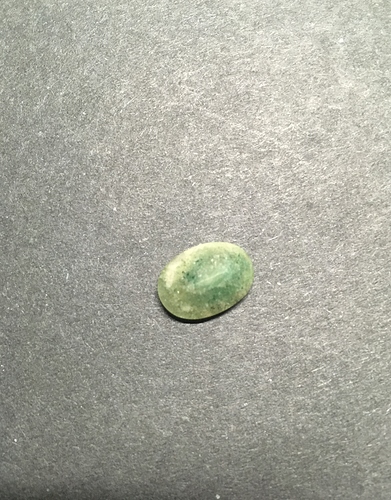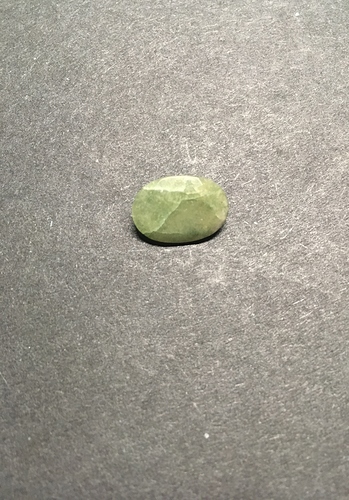Hello everyone, I was wondering if anyone could identify this gemstone, judging by the color it didn’t really look like an emerald to me, I also tried scratching it with a ruby and it didn’t leave a mark on it. I was thinking maybe it is a rough tourmaline but I’m not sure
Does it really matter? From the looks of that crack, it likely will become two stones anyway. Doesn’t look like either emerald or tourmaline, but in either case it’s pretty low grade. My guess would be serpentine or some sort of feldspar.
Thanks for the reply. Yeah I know it’s poor quality, the reason I asked is because I’m pretty new to gemology and I’m not yet good with identifying gems.
Your guess of emerald is not too far off…just needs a lot more green color!
Just a guess based on your pics…
I think it may be Beryl, which comes in many colors, the deep green we know of as emerald. This seems to have some yellow hues in it so it could be Heliodor, a form of Beryl. Beryl in its most pure form is actually clear, the color depends upon what impurities were present when it was formed. Because this stone has darker hues on top and slightly lighter hues on the cracked side, I would guess Heliodor.
Beryl is also brittle, thus, the cracks in the stone. To test, Beryl is 7.5 - 8 hardness, colorless streak test
This being opaque is very common and not worth a lot because its not gemmy or clear.
Thank you for replying
I to am very new to gemology and feel compelled to add this as food for thought…while this specimen may not have monetary value, it is still valuable because it fosters discussion. Knowledge is gained every time those who can, teach what they know, so others may learn. And that in my opinion is priceless.
If you can’t scratch it with a ruby (high hardness)… then it isn’t tourmaline (moderate hardness), isn’t serpentine (really soft), and isn’t beryl (moderate hardness). I have seen a considerable amount of corundum that is cloudy and has an off-colored green shade to it, and would vaguely be called a sapphire (which is any color other than pigeon blood red).
I enlarged the image 500% and I suspect these are neither. They are made up of tiny little beads of different shades of green to grey. Like an oolite? A low grade of nephrite maybe, depending on hardness. The lines across the second one look rather like grinding flats.
Bob
does emerald or beryl have the spotty look that it shows on the back of the stone?
The beads of different shades you are looking at, with that magnification, is more than likely due to the enlargement of the pixels. I also tried magnifying the pic but the original image is not a high enough quality.
Yes, they both can as emerald…is beryl. Beryl, when formed with Chromium, gets the beautiful green color we know as emerald. The shade of green, be it high quality emerald or a low grade, is caused by the amount of chromium present while the beryl is formed.

I happened across this pic of a Beryl crystal. Notice how the stone you have could have been cut from the top portion of this crystal? The back of your stone has the lighter color of the top of this crystal and the face has the slightly greener color.
Of course…there is nothing better than having a stone or gem in hand to tell what it really is. You can check how light refracts through it, weight, inclusions and/or types of other imperfections that may be in the stone, how it reacts to different type of light.
Then there is the old standby…take it to a local rock shop, they should be able to tell you what it is for sure!
Hope that helps!
If you could get an Refractive index & if DR birefringence, if faceted, or a spot reading if not that would be very helpful as it is not one of the few gems that can be identified from appearance only.
pelo meu conhecimento básico, a parte branca seria parte da matriz da esmeralda, feldspato e berilo branco, com agulhas de berilo verde, em fase de crescimento e cristalização, porem sofreu um rápido resfriamento interrompendo a cristalização, antes da formação da gema, e total cristalização ou pode ter faltado cargas de cromo ou vanádio, que a deixaria com um cor mais verde, pois por falta de um ou os dois elementos, ela acabou ficando fosca e sem brilho, mas com um tratamento de oleo, ela melhorará em mais de 100% na cor dela, e melhoraria o brilho dela também, tornando se assim uma esmeralda mais desejável, um verde mais vivo.
by my basic knowledge the white part would be part of the matrix of the emerald, feldspar and white beryl, with green beryl needles, in the growth and crystallization phase, however it suffered a rapid cooling interrupting the crystallization, before the formation of the yolk, and total crystallization or it may have lacked loads of chrome or vanadium, which would make it a greener color, because for lack of one or both elements, it ended up becoming dull and dull, but with an oil treatment, it will improve by more than 100 % in its color, and would improve its brightness as well, thus becoming a more desirable emerald, a more vivid green
I was thinking of a local gemmology club too?

